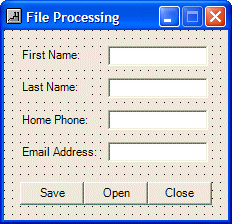
File Information
 |
File Information |
|
In its high level of support for file processing, the .NET Framework provides the FileInfo class. This class is equipped to handle all types of file-related operations including creating, copying, moving, renaming, or deleting a file. FileInfo is based on the FileSystemInfo class that provides information on characteristics of a file.
|
|||||||||||||||||||||||||||||||||||||||||||||||||||||||||||||||||||||||||||||||||||||||||||||||||||||||||||||||||||||||||||||||||||
|
File Initialization |
|
The FileInfo class is equipped with one constructor whose syntax is: public: FileInfo(String* fileName); This constructor takes as argument the name of a file or its complete path. If you provide only the name of the file, the compiler would consider the same directory of its project. Here is an example: private: System::Void btnSave_Click(System::Object * sender, System::EventArgs * e)
{
FileInfo *fleMembers = new FileInfo(S"Second.txt");
}
Alternatively, if you want, you can provide any valid directory you have access to. In this case, you should provide the complete path. |
|
File Creation |
|
The FileInfo constructor is mostly meant only to indicate that you want to use a file, whether it exists already or it would be created. Based on this, if you execute an application that has only a FileInfo object created using the constructor as done above, nothing would happen. To create a file, you have various alternatives. If you want to create one without writing anything in it, which implies creating an empty file, you can call the FileInfo::Create() method. Its syntax is: public: FileStream* Create(); This method simply creates an empty file. Here is an example of calling it: private: System::Void btnSave_Click(System::Object * sender, System::EventArgs * e)
{
FileInfo *fleMembers = new FileInfo(S"Second.txt");
fleMembers->Create();
}
The FileInfo::Create() method returns a FileStream object. You can use this returned value to write any type of value into the file, including text. If you want to create a file that contains text, an alternative is to call the FileInfo::CreateText() method. Its syntax is: public: StreamWriter* CreateText(); This time, this method directly returns a StreamWriter object. You can use this returned object to write text to the file. |
|
File Existence |
|
When you call the FileInfo::Create() or the FileInfo::CreateText() method, if the file passed as argument or as the file in the path of the argument exists already, it would be deleted and a new one would be created with the same name. This can cause the right file to be deleted. Therefore, before creating a file, you may need to check whether it exists already. To do this, you can check the value of the Boolean FileInfo::Exists property. This property holds a true value if the file exists already and it holds a false value if the file doesn't exist or it doesn't exist in the path. Here is an example of checking the existence of a file: |
private: System::Void btnSave_Click(System::Object * sender, System::EventArgs * e)
{
FileInfo *fleMembers = new FileInfo(S"Second.txt");
fleMembers->Create();
if( fleMembers->Exists == true )
return;
}
|
Writing to a File |
|
As mentioned earlier, the FileInfo::Create() method returns a FileStream object. You can use this to specify the type of operation that would be allowed on the file. To write normal text to a file, you can first call the FileInfo::CreateText() method. This method returns a StreamWriter object. The StreamWriter class is based on the TextWriter class that is equipped with Write() and WriteLine() methods used to write values to a file. The Write() method writes text on a line and keeps the caret on the same line. The WriteLine() method writes a line of text and moves the caret to the next line. After writing to a file, you should close the StreamWriter object to free the resources it was using during its operation(s). Here is an example: |
 |
private: System::Void btnSave_Click(System::Object * sender, System::EventArgs * e)
{
FileInfo *fleMembers = new FileInfo(S"Second.txt");
StreamWriter *swrMembers = fleMembers->CreateText();
try {
swrMembers->WriteLine(txtFirstName->Text);
swrMembers->WriteLine(txtLastName->Text);
swrMembers->WriteLine(txtHomePhone->Text);
swrMembers->WriteLine(txtEmailAddress->Text);
txtFirstName->Text = S"";
txtLastName->Text = S"";
txtHomePhone->Text = S"";
txtEmailAddress->Text = S"";
txtFirstName->Focus();
}
__finally
{
swrMembers->Flush();
swrMembers->Close();
}
}
|
|
|
|
|
Appending to a File |
|
You may have created a text-based file and written to it. If you open such a file and find out that a piece of information is missing, you can add that information to the end of the file. To do this, you can call the FileInfo::AppenText() method. Its syntax is: public: StreamWriter* AppendText(); When calling this method, you can retrieve the StreamWriter object that it returns, then use that object to add new information to the file. |
|
|
|
|
|
||
| Home | Copyright © 2005-2016, FunctionX | Next |
|
|
||